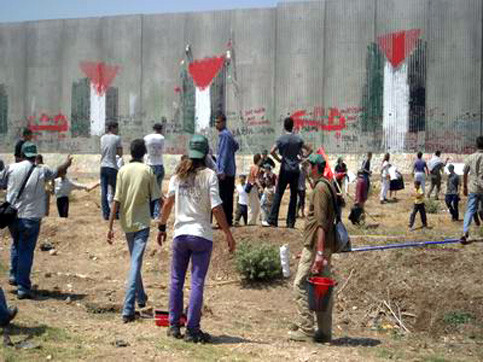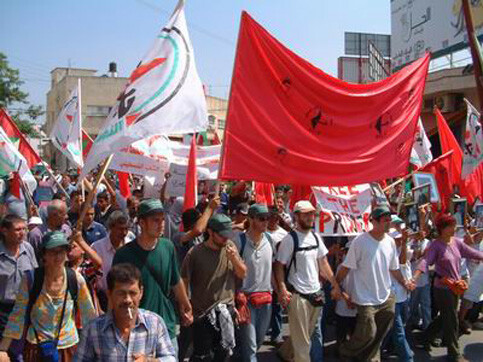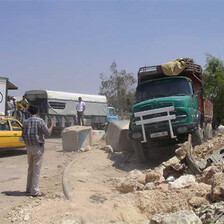
(Guiseppi)
Life here on the ground in occupied Palestine is rarely reported in the United States. The brutal impact of Israel’s military occupation is hidden behind the rhetoric of pundits and politicians, many of whom have never met a Palestinian. They have never, as I have, held a sick Palestinian child in their arms as her parents beg soldiers to let them pass a checkpoint. They have never babysat Palestinian children while their mother goes out to find out what happened to her husband during an armed invasion of their refugee camp. Talk of a “roadmap” is cold comfort to a Palestinian doctor who is not allowed to travel the road from his home to the hospital or to a Palestinian farmer whose lands have been made inaccessible to him due to the construction of a separation wall that is anything but a “security fence.”
Since my arrival in Palestine on July 1, 2003, I have seen things that most Americans, which sadly includes American journalists, will never see thanks to the blackout in the American media when it comes to factual descriptions of daily life in Palestine.

(Guiseppi)
On Tuesday, August 12, I joined over 60 international peace workers and over 200 residents of the West Bank town of Qalqilia to protest Israel’s construction of a 25 foot high concrete apartheid wall. In Qalqilia, the wall circles for 7 miles, completely sealing off the town. During the march from the civic center to the wall, children flew kites with ribbons the color of the Palestinian flag. Women’s groups carried signs demanding the release of their husbands and sons being held as political prisoners. Young men carried signs with messages such as: “Learn from history: Welcome to the Qalqilia Concentration Camp.”
Indeed, by turning the town into a veritable ghetto, Israel has devasted the lives of the 33,000 men, women, and children who live in Qalqilia. Once, the town thrived on commerce with Israelis who would shop there looking for bargains. Now, no Israelis or other tourists are allowed in through the one checkpoint that controls entrance to and exit from the town. As a result, one third of the town’s businesses were forced to close and unemployment soared to 65%. The group of internationals I was with had to find a back way into the town through the fields.
Isolated from Israel and other Palestinian municipalities, Qalqilia had to rely on its agriculture to survive. But by the time the construction of the ghetto wall began on August 15, 2002, Israel had made its decision to confiscate 35% of Qalqilia’s land and another 225 acres were isolated from the town on the other side of the wall. Farmers are regularly denied access to fields and pastures by Israeli soldiers. Families are cut off from each other, pregnant women are cut off from hospitals, and children are cut off from schoolyards.
Moreover, Israel confiscated 15 of the town’s 39 precious wells, causing the people of Qalqilia to lose a third of their water supply. Vital irrigation systems have been destroyed as well. U.S.-made Caterpillar bulldozers have uprooted thousands of ancient olive and citrus trees.
“We are living in a prison. The city was once like a garden, but now we are in hell,” one resident of Qalqilia told me during the march from the civic center to the wall. “And think about the children. What does this say to them? It says, ‘You have no freedom. You have no future.’”
After the demonstration, which included painting the wall with the flag of Palestine and releasing 36 white doves (one for each year of occupation since 1967), I travelled back to Jenin where the situation is growingly similarly dire. I went to the village of Jalbon outside of Jenin and enjoyed unparalled hospitality from the people there during my 5 day stay. Even though my country sends military and financial aid amounting to $10 billion every year to support Israel’s illegal military occupation, I was constantly met with, “A’halan wa sa’halan!” “You are most welcome here.”
A group of internationals from the United States, Great Britain, Canada, and Sweden met with the mayor of Jalbon and the school principal to discuss the occupation in general and the impact of the wall specifically. We also met a shepherd in Jalbon whose livelihood has been severely impacted by the wall. His fields have been confiscated by the Israelis, and most his land is now on the other side of the wall. On what little land he has left, he cannot use to graze his sheep due to threats from Israeli soldiers who patrol the wall.
We went out each morning with the shepherd and his flock in an attempt to protect him from violence and harrassment by Israeli soldiers. Our work was successful, according to the shepherd who told us that our presence was instrumental in giving his flock of sheep and goats their first good grazing in months. “But you cannot stay here forever. The soldiers will be back.”
In Jalbon alone, over 500 acres of residential and agricultural land have been confiscated by the Israelis for the construction of the apartheid wall which is not being built along the 1967 border with Israel, but in some places as much as 2 miles inside Palestinian territory. The loss of land in Jalbon amounts to over 500 acres - the size of George Washington’s ancestral estate, Mount Vernon, outside of Washington, DC. It is roughly one third of George W. Bush’s ranch in Crawford, TX . For Jalbon, a small farming village which had already had hundreds of acres stolen after the 1967 war, this constitutes a devastating loss of land, water, and source of livelihood.

(Guiseppi)
By holding the trump card of “anti-Semitism,” Israel is able to sustain the world’s longest military occupation. Every day, the ghetto wall around the West Bank and Gaza grows longer and higher. It will stretch for 280 miles - 3 times longer than the wall built by the Communists to separate East and West Berlin… and more than 25 times longer than the wall built by the Nazis to seal off the Warsaw Ghetto.
Whether attempting to force Palestinians from their homes by violence, harrassment, economic strangulation, or starvation, ethnic cleansing is ethnic cleansing. The Palestinians have literally been forced up against the wall, with nowhere to turn, and no one to turn to. How long will the world contintue to watch silently?
If nothing else, the international peace activists I’ve been working with have shattered the consensus that Israel is immune from criticism for its barbaric actions. The noble work of 100 activists, however, cannot compare with what would happen if just 10 nations said “Enough!” to Israel’s barbaric occupation of Palestine. Actually, all it would take is the action of one nation, the U.S., to hold Israel accountable for its crimes against humanity. The occupation is a direct violation of the fundamentals of American democracy. The cry of the Palestinians could easily be transposed into our own Declaration of Independence.
And by helping to force Palestinians up against the wall, the U.S. is complicit in not only oppressing 3.5 million civilians who simply want to live normal lives: We are actively compromising our own security and the security of Israel as well.
Daniel Quinn is a licensed clinical social worker with a local public school system. Last summer, he lived and worked for 2 months in the Gaza Strip and the West Bank, volunteering as a clinical consultant with the Palestine Children’s Relief Fund.



